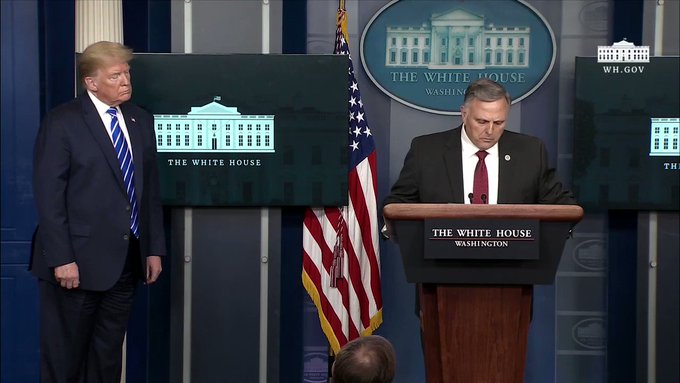Top DHS Official: Coronavirus Dies Fastest In Sunlight, Heat, Humidity
Bill Bryan, an undersecretary at the Homeland Security Department, said during the White House Coronavirus Task Force news conference that the coronavirus dies the fastest when exposed to sunlight, heat, and humidity.
“Our most striking observation to date is the powerful effect that solar light appears to have on killing the virus, both surfaces and in the air,” Bryan said. “We’ve seen a similar effect with both temperature and humidity as well, where increasing the temperature and humidity, or both, is generally less favorable to the virus.”
Bryan showed a variety of results that DHS researchers found when looking at the half-life of the coronavirus.
Half-life of SARS-CoV-2 in saliva droplets:
Virus does not last long in high temperature, humidity & sunlight.
917 people are talking about this
“We don’t measure the virus as far as how long will it live on a surface, we to measure the decay of the virus, in terms of its half-life because we don’t know certain elements,” Bryan said. “We don’t know how much a person expectorates when he spits … when he sneezes, whatever the case may be, we don’t know how much virus is in there.”
“So that has a bearing on how long the virus is going to be alive and active, so we measure in half-life because half-life doesn’t change,” Bryan continued. “So if you look at an 18 hour half-life, what you’re basically is seeing is that every 18 hours, the life of the virus is cut in half. So, if you start with a thousand particles of the virus, in 18 hours, you’re down to 500, in 18 hours after that, you’re down to 250, and so on and so forth.”
“So the virus is dying at a much more rapid pace, just from exposure to higher temperatures and just from exposure to humidity,” Bryan concluded. “If you look at the fourth line, you inject the sunlight into that, you inject UV rays into that, the same effects on line two as 70-75 degrees with 80% humidity on the surface and look at line four, but now you inject the sun, the half-life goes from 6 hours to 2 minutes. That’s how much of an impact that UV rays [have] on the virus.”
WATCH:
Interesting information about how increased temperature, humidity, and solar light are detrimental to Coronavirus in saliva droplets.
662 people are talking about this
TRANSCRIPT:
As part of our efforts we are leveraging the unique capabilities of the S&T’s national bio defense analysis and countermeasure center to study the biology of the COVID-19 virus. This center is a high-bio containment laboratory located in Frederick, Maryland. It was established in the early 2000s in response to the Amerithrax attacks, and where study, characterize, analyze, develop countermeasures for biological threats to the homeland. We work closely with the CDC, FDA, HHS, and also our Department of Defense colleagues, and many others. Yesterday, I shared the emerging results of our work that we are doing now with the coronavirus task force, and today, I would like to share certain trends that we believe are important. If I may have the first slide, please. While that is coming up, our most striking observation to date is the powerful effect that solar light appears to have on killing the virus, both surfaces and in the air.We’ve seen a similar effect with both temperature and humidity as well, where increasing the temperature and humidity, or both, is generally less favorable to the virus. Let me illustrate with this first slide. If you look to the right, you see that term “half-life” with a bunch of time stamps on there. First, let me tell you what a half-life is. We don’t measure the virus as far as how long will it live on a surface, we have to measure the decay of the virus in terms of its half-life because we don’t know certain elements. We don’t know how much a person expectorates when he spits, right, when he sneezes, whatever the case may be, we don’t know how much virus is in there.So that has a bearing on how long the virus is going to be alive and active, so we measure in half-life because half-life doesn’t change. So if you look at an 18 hour half-life, what you’re basically is saying is that every 18 hours, the life of the virus is cut in half. So, if you start with a thousand particles of the virus, in 18 hours, you’re down to 500, in 18 hours after that, you’re down to 250, and so on and so forth.That’s important as I explain the rest of the chart. If you look at the first three lines, and you see the word “surface,” we’re talking about non-porous surfaces – door handles, stainless steel – and if you look, as the temperature increases and as the humidity increases with no sun involved, you can see how drastically the half-life goes down on that virus. So the virus is dying at a much more rapid pace just from exposure to higher temperatures and just from exposure to humidity. If you look at the fourth line, you inject the sunlight into that, you inject UV rays into that, the same effects on line two as 70-75 degrees with 80% humidity on the surface and look at line four, but now you inject the sun, the half-life goes from 6 hours to 2 minutes. That’s how much of an impact that UV rays has on the virus.



